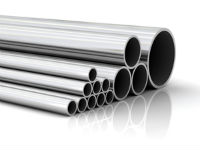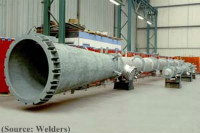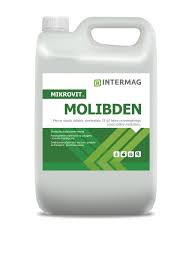- Molybdenum is a valuable alloying agent in various steels, as it not only contributes to their toughness, but also improves the corrosion resistance and weldability of the steels. Approximately 80% of this metal is used in the production of various steels, such as structural steels, stainless steels, high-speed steels, tool steels and so on.
 Structural steels account for 35% of all molybdenum demand. Molybdenum is used in structural steels because of its corrosion resistance, strength and durability. Such steels are very useful in protecting metals against chloride corrosion, thus they are used in a wide range of marine environment applications (e.g. offshore oil rigs), as well as oil and gas pipelines.
Structural steels account for 35% of all molybdenum demand. Molybdenum is used in structural steels because of its corrosion resistance, strength and durability. Such steels are very useful in protecting metals against chloride corrosion, thus they are used in a wide range of marine environment applications (e.g. offshore oil rigs), as well as oil and gas pipelines. Stainless steels consume about 25% of molybdenum supply, which value the metal's ability to strengthen and inhibit corrosion. Stainless steels are used in pharmaceutical and chemical mills, tanker trucks and so on.
Stainless steels consume about 25% of molybdenum supply, which value the metal's ability to strengthen and inhibit corrosion. Stainless steels are used in pharmaceutical and chemical mills, tanker trucks and so on. Tool and high-speed steels account for 9% of molybdenum consumption, while superalloys account for 5%. Molybdenum in these steels can increase their hardness and resistance to wear and deformation at high temperatures. High-speed steels are used to produce cutting tools and drills, whereas superalloys are used to produce jet engines, turbo chargers and power generation turbines.
Tool and high-speed steels account for 9% of molybdenum consumption, while superalloys account for 5%. Molybdenum in these steels can increase their hardness and resistance to wear and deformation at high temperatures. High-speed steels are used to produce cutting tools and drills, whereas superalloys are used to produce jet engines, turbo chargers and power generation turbines. About 6% of molybdenum produced every year goes into increasing the strength, hardness, temperature and pressure tolerance of cast iron which is used to produce cylinder heads, motor blocks and exhaust manifolds. These parts allow automobile engines to run hotter, thus reducing carbon emissions.
About 6% of molybdenum produced every year goes into increasing the strength, hardness, temperature and pressure tolerance of cast iron which is used to produce cylinder heads, motor blocks and exhaust manifolds. These parts allow automobile engines to run hotter, thus reducing carbon emissions. Molybdenum is also used in certain nickel-based alloys because it can improve the strength of steel at high temperatures. When alloyed with nickel, molybdenum forms heat and corrosion resistant materials used in the chemical industry, such as "Hastelloys(R)".
Molybdenum is also used in certain nickel-based alloys because it can improve the strength of steel at high temperatures. When alloyed with nickel, molybdenum forms heat and corrosion resistant materials used in the chemical industry, such as "Hastelloys(R)".
 Molybdenum compounds are usually used in the chemical industry as catalysts and lubricants. For example, molybdenum sulfide is employed as a catalyst to eliminate sulfur in the refining of petroleum, and it is also a useful lubricant, especially at high temperatures where oils would decompose. In addition, some molybdenum compounds are also used as pigments for plastics, corrosion inhibitors, ceramics and smoke suppressants. About 14% of the molybdenum extracted is used in the chemical industry.
Molybdenum compounds are usually used in the chemical industry as catalysts and lubricants. For example, molybdenum sulfide is employed as a catalyst to eliminate sulfur in the refining of petroleum, and it is also a useful lubricant, especially at high temperatures where oils would decompose. In addition, some molybdenum compounds are also used as pigments for plastics, corrosion inhibitors, ceramics and smoke suppressants. About 14% of the molybdenum extracted is used in the chemical industry.
 Because molybdenum has a high melting point, it is used to produce the electrodes of electrically heated glass furnaces. Some electrical filaments are also made from molybdenum.
Because molybdenum has a high melting point, it is used to produce the electrodes of electrically heated glass furnaces. Some electrical filaments are also made from molybdenum.
 Molybdenum is an important trace element for plants because it is an essential component of the enzyme nitrogenase, which helps convert atmospheric nitrogen into ammonia, so molybdenum powder is used as a fertilizer for some plants, such as cauliflower.
Molybdenum is an important trace element for plants because it is an essential component of the enzyme nitrogenase, which helps convert atmospheric nitrogen into ammonia, so molybdenum powder is used as a fertilizer for some plants, such as cauliflower.- Molybdenum is also used in medical field. For example, the radioactive isotope molybdenum-99 is used to generate technetium-99m, which is used for medical imaging.
- High purity molybdenum metal is used in a range of applications from powder coatings to solar cells and flat panel display coatings.
-
About us
Contact us
Make a suggestion
- Metalpedia is a non-profit website, aiming to broaden metal knowledge and provide extensive reference database to users. It provides users reliable information and knowledge to the greatest extent. If there is any copyright violation, please notify us through our contact details to delete such infringement content promptly.
 Structural steels account for 35% of all molybdenum demand. Molybdenum is used in structural steels because of its corrosion resistance, strength and durability. Such steels are very useful in protecting metals against chloride corrosion, thus they are used in a wide range of marine environment applications (e.g. offshore oil rigs), as well as oil and gas pipelines.
Structural steels account for 35% of all molybdenum demand. Molybdenum is used in structural steels because of its corrosion resistance, strength and durability. Such steels are very useful in protecting metals against chloride corrosion, thus they are used in a wide range of marine environment applications (e.g. offshore oil rigs), as well as oil and gas pipelines. Stainless steels consume about 25% of molybdenum supply, which value the metal's ability to strengthen and inhibit corrosion. Stainless steels are used in pharmaceutical and chemical mills, tanker trucks and so on.
Stainless steels consume about 25% of molybdenum supply, which value the metal's ability to strengthen and inhibit corrosion. Stainless steels are used in pharmaceutical and chemical mills, tanker trucks and so on. Tool and high-speed steels account for 9% of molybdenum consumption, while superalloys account for 5%. Molybdenum in these steels can increase their hardness and resistance to wear and deformation at high temperatures. High-speed steels are used to produce cutting tools and drills, whereas superalloys are used to produce jet engines, turbo chargers and power generation turbines.
Tool and high-speed steels account for 9% of molybdenum consumption, while superalloys account for 5%. Molybdenum in these steels can increase their hardness and resistance to wear and deformation at high temperatures. High-speed steels are used to produce cutting tools and drills, whereas superalloys are used to produce jet engines, turbo chargers and power generation turbines. About 6% of molybdenum produced every year goes into increasing the strength, hardness, temperature and pressure tolerance of cast iron which is used to produce cylinder heads, motor blocks and exhaust manifolds. These parts allow automobile engines to run hotter, thus reducing carbon emissions.
About 6% of molybdenum produced every year goes into increasing the strength, hardness, temperature and pressure tolerance of cast iron which is used to produce cylinder heads, motor blocks and exhaust manifolds. These parts allow automobile engines to run hotter, thus reducing carbon emissions. Molybdenum is also used in certain nickel-based alloys because it can improve the strength of steel at high temperatures. When alloyed with nickel, molybdenum forms heat and corrosion resistant materials used in the chemical industry, such as "Hastelloys(R)".
Molybdenum is also used in certain nickel-based alloys because it can improve the strength of steel at high temperatures. When alloyed with nickel, molybdenum forms heat and corrosion resistant materials used in the chemical industry, such as "Hastelloys(R)". Molybdenum compounds are usually used in the chemical industry as catalysts and lubricants. For example, molybdenum sulfide is employed as a catalyst to eliminate sulfur in the refining of petroleum, and it is also a useful lubricant, especially at high temperatures where oils would decompose. In addition, some molybdenum compounds are also used as pigments for plastics, corrosion inhibitors, ceramics and smoke suppressants. About 14% of the molybdenum extracted is used in the chemical industry.
Molybdenum compounds are usually used in the chemical industry as catalysts and lubricants. For example, molybdenum sulfide is employed as a catalyst to eliminate sulfur in the refining of petroleum, and it is also a useful lubricant, especially at high temperatures where oils would decompose. In addition, some molybdenum compounds are also used as pigments for plastics, corrosion inhibitors, ceramics and smoke suppressants. About 14% of the molybdenum extracted is used in the chemical industry. Because molybdenum has a high melting point, it is used to produce the electrodes of electrically heated glass furnaces. Some electrical filaments are also made from molybdenum.
Because molybdenum has a high melting point, it is used to produce the electrodes of electrically heated glass furnaces. Some electrical filaments are also made from molybdenum. Molybdenum is an important trace element for plants because it is an essential component of the enzyme nitrogenase, which helps convert atmospheric nitrogen into ammonia, so molybdenum powder is used as a fertilizer for some plants, such as cauliflower.
Molybdenum is an important trace element for plants because it is an essential component of the enzyme nitrogenase, which helps convert atmospheric nitrogen into ammonia, so molybdenum powder is used as a fertilizer for some plants, such as cauliflower.